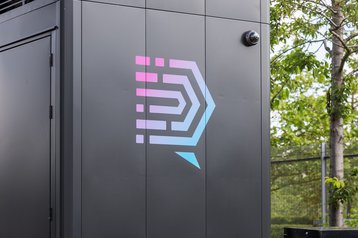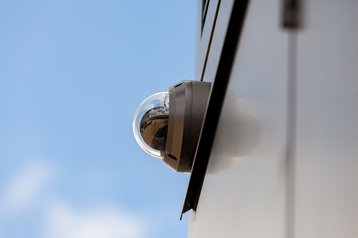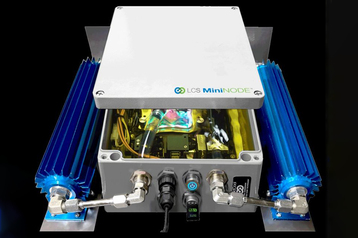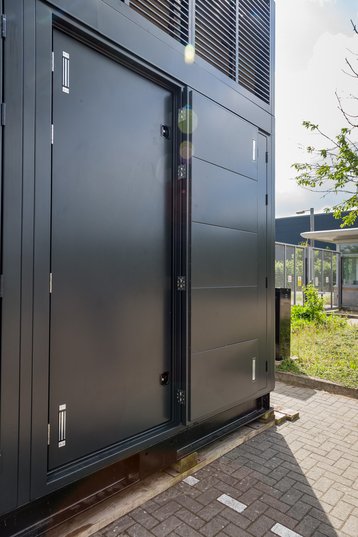When you think of data centers you probably think of massive buildings which are very secure and full of cabinets that store a copious amount of data. And often you’d be right to think that.
The Edge is different, of course. Here the resources are installed in smaller units that can be placed out of doors, close to applications, and also close to communication links such as cell towers, which they rely on to link up with their mobile devices, and also for backhaul to the cloud.
But in its short lifetime, the Edge has spawned its own cliche: Data centers consist of a few racks installed in a standard-issue ISO shipping container, or else in a customized box the size of an ISO unit.
There’s a reason for that. Edge resources have to be delivered to the sites where they will operate, and those units, are rugged, reliable, and can conveniently be placed on standard articulated trucks for delivery where they will be needed
But that’s not the only way to do things.
Edge like a telco cabinet
UK startup Dataqube is aiming to get the data center market to think differently when deploying Edge data center resources.
Based in Cambridge, UK, Dataqube is looking to take a different approach to deliver capabilities around the Edge, perhaps taking a leaf out of the closely-related telecoms market. Its Edge facilities are literally housed in square-shaped cabinets it calls ‘pods’.
Founded in 2020, the company’s Edge pods are basically flexible roadside cabinets. Dataqube says they are more transportable and relocatable than the traditional containers, claiming they can be up and running within 24 hours.
Dataqube chief operating officer Steve Pass told DCD about the company’s ambition to scale out its offering, bypassing limiting factors adopted by others.
Pass said that the company wanted to avoid the bricks-and-mortar approach that many traditional data center companies have used.
“Fundamentally Dataqube is a flexible, scalable data center solution,” he said, noting that Dataqube can build pods to any particular size or shape.
“Our pods are not built to a particular fixed size, or a certain dimension and this means we can deploy Edge data centers of all sizes. We want to try and challenge the traditional ways of building data centers."
Different types
Essentially, Dataqube’s boxes are rugged cabinets with a square footprint big enough to hold a rack. They can be linked together in any orientation.
The cabinets themselves provide an IP-rated outer structure to protect all internal equipment, and can be installed indoors or outdoors.
Some cabinets hold specialized kit including the power distribution units and switchgear, while another will hold an uninterruptible power supply (UPS), which Dataqube says can deliver reliability equivalent to Tier IV, if required. Generators can also be added.
Each cabinet has space on top, for a cooling system, and all have built-in fire suppression and detection, with a self-activating fire extinguishing system
There’s also built-in 24×7 security monitoring and intruder detection using CCTV installed on the exterior of each pod.
The IT rack cabinets can support up to 30kW IT load, which can be extended to 100kW if customers take up the option of liquid cooling.
Dataqube’s Pass says the company can fit its data centers into existing structures and infrastructure, rather than having to alter them.
“We have the ability to build however we want to, whether this is in straight lines or in different shapes or sizes. We can even build our data centers around existing infrastructure if this is necessary.”
Cost is a key consideration too when building out data centers, and Pass says that building out these cubes is up to 50 percent cheaper than in more traditional ways. Deploying the pods is also quicker than the more traditional data centers too, he adds.
The pods can extend to quite large systems, says Pass, who notes that the largest installation so far was 60 megawatts, although some of Dataqube’s smaller pods can be between 7 to 10 kilowatts.
Investment in the business
The company is currently led by CEO Claude Sassoulas, who was appointed in August 2022.
Sassoulas replaced Dataqube founder David Keegan in the role, and most recently spent four years as COO at InterCloud, a Paris-based European software-defined cloud interconnect provider.
Sassoulas describes Dataqube as “disruptive.” It has raised some investment, most recently €26 million ($29m) in Series A funding from French investment management company Rgreen Invest in December of 2021.
It's Rgreen’s first venture into the data center market, with the firm intent on investing in sustainability projects.
When the investment from Rgreen was confirmed, then-CEO Keegan said: “Our goal has always been to develop a sustainable solution to support the data center industry in its drive to reduce CO2 targets in line with CSR policies.”
Sustainability key for Dataqube
Data center energy demands are high on tech companies’ agenda, and the arrival of the Edge will add yet more to the power budget.
Centralized data centers have been working hard to reduce their environmental footprint, choosing locations like Sweden, where cooling is available for free, consolidating technologies into large facilities to get the economies of scale, and signing large power supply deals that give them access to renewable energy sources.
All these options are not available - or may be problematic - at the Edge. But despite this, Pass says Dataqube has been able to adopt certain techniques that turn the Edge into an environmental advantage.
One obvious difference is the size of the cabinets. Conventional containers are designed to be accessed and managed by humans who will climb inside to work on the racks.
Dataqube’s smaller modules are accessed from outside. This means they embody less raw material, but the elimination of “human space” inside the cabinet is itself a benefit, says Pass.
Without human space, he says, operators can reduce power consumption because there’s no need for lighting, or air conditioning for engineers.
He’s also proud of the cooling options. The Dataqube cabinets use outside air cooling for the air-cooled option (up to 30kW), and liquid cooling for the more dense options from 30kW to 100kW.
Liquid cooling investment
Earlier in 2022 Dataqube invested in cooling specialist LiquidCool, and gained exclusive market rights to its products.
LiquidCool first spoke to DCD back in 2014, and launched a liquid-cooled Edge appliance in 2017, in which each blade is separately sealed in a module in which coolant circulates.
Dataqube has access to a new Edge module, developed from LiquidCool’s earlier technology. MiniNode is a sealed box for Edge applications like cell towers and other harsh environments. The liquid-cooled system inside uses eco-friendly dielectric fluids.
The company also provides ZPserver ("Zero Pressure Server") units - modular sealed units which fit into existing server racks and have a claimed partial PUE 1.03.
LiquidCool claims that: "One liquid-cooled rack can replace four air-cooled racks within a data center, saving energy and space and eliminating capital and maintenance costs. No more complex air handling systems, ductwork, filters, or CRAC units."
Pass says liquid cooling is the most efficient for reducing power consumption: “The primary thing for us is to significantly reduce the power we use. We use liquid cooling instead of air cooling, as it is better for reducing power consumption.”
Last year the average Power Usage Effectiveness (PUE) for the data center industry was 1.57 PUE. Pass claims that with Dataqube’s liquid cooling, this number can be reduced to as little as 1.05 PUE.
Maintenance support
Servicing Edge resources can be a minefield. Centralized data centers locate all the equipment close together in one building, and can afford on-site tech support.
By contrast, Edge applications installed across small distributed facilities like Dataqubes, cannot rely on on-the-premises support. Any tech intervention will require an engineer to visit or, at the very least, a set of equipment and instructions must be delivered to local less-technical staff.
Dataqube customers have a choice, says Pass. They can either buy repairs and maintenance from Dataqube as additional aftersales or else opt to do it themselves.
“We’re very open with our customers about the option of servicing these pods,” said Pass. “It's a service that many of our customers take because they find this easier. It’s especially easier for customers that have multiple deployments across different locations.”
For those that do take out the option of having their Dataqube serviced, Pass says the company is on hand to watch the systems’ performance.
“We are able to closely monitor these data centers 24/7 and offer full mechanical or electrical support maintenance too. So if something does happen, even if there’s just a warning that something isn’t right, we’re able to quickly react to it.
“Because we’re trying to be as sustainable as possible we want to build data cubes as closely located to our partners as possible. But we also want to ensure that we have support networks nearby too. To do this, we work with local partners and suppliers to offer our partners the correct level of support, no matter what country they are in.”
Mind the doors
There is an additional issue to consider with servicing Edge equipment, which data center authority ASHRAE (the American Society of Heating, Refrigeration and Air-conditioning Engineers) has flagged up in recent years.
Traditional data centers are buildings with doors, so a visiting engineer can enter and open a cabinet without exposing it to any extreme conditions. Even containerized units offer this protection to their equipment.
But small cabinets like Dataqube’s open directly to the air and are maintained by an engineer standing outside. Opening the box can expose equipment outside to unexpected temperature or humidity levels, or allow dust and dirt into the cabinet.
“Many items that are non-issues for brick and mortar data centers are real issues for small edge data centers,” ASHRAE technical committee member Jon Fitch told DCD in 2020.
Telecoms networks are already deployed in cabinets, but they use hardened equipment, built to specifications like NEBS, defined by AT&T in the 1970s.
Anyone putting IT equipment in a roadside cabinet will have to ensure that the whole package can withstand having its doors opened in a range of conditions, and that engineers operating on the systems will take due precautions beyond those required in a building or a container,
Security is something that Pass is keen to address too, noting that the Dataqube is made out of stainless steel, with no exterior door handles that can be opened up, and no card readers that can be accessed. Naturally, CCTV adds an additional layer of protection.
Powering the pods
In March of this year, Dataqube announced that it will supply 20 of its pods to Australian firm Edge Centers. The company is also manufacturing pods to be deployed across Europe, America, and Africa, says Pass.
However, he didn’t specify any targets or any figure on how many have been deployed so far but added that Dataqube will be active with these deployments in the next six to 12 months.
“Our biggest opportunity is to provide a flexible, scalable, and sustainable offering to the Edge market,” said Pass.
He adds that a challenge for the industry as a whole has been adapting to change, using the example that the way data centers have been built now is not much different from what it was about 30 years ago, even though the world and the data we consume have significantly grown.
If the industry can come together and work on reducing consumption power, Pass is confident that the data center industry will become more sustainable.
More in Edge & IoT
-

-

-

Episode On the Edge of entertainment





